#Tammany Hall
Note
great info on the mayors / political leaders of New York - on the anti side, how about the absolute worst and most destructive , regressive, or otherwise harmful in its history?
This one is mostly covered by my first post about NYC mayors, where I discussed the mayors from Lindsay to the present.
However, I can talk about earlier mayors, even though most of them were bland non-entities. One major exception to this rule was Fernando Wood.
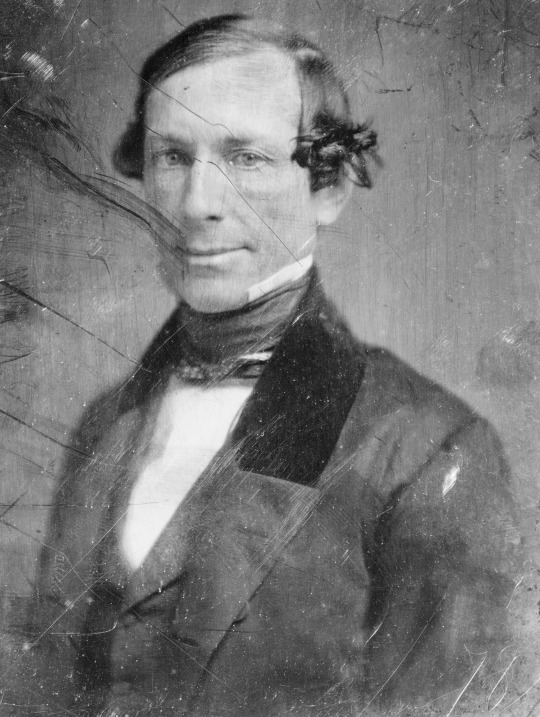
If there was one consistent theme of Wood's career - other than fraud (Wood stole from his bank and his own brother-in-law) and corruption - it was racism and violence.
From the very beginning of Wood's political career, he distinguished himself as the most pro-slavery man in New York Democratic politics, seeking the patronage of figures like John C. Calhoun and James Buchanan. When he shifted from Congress to mayoral politics, Wood went back and forth on what variety of pro-slavery politics he preferred (variously backing Douglas' popular sovereignty position and Buchanan's anti-Douglas position), but was a consistent enemy of John Van Buren's Free Soil Democrats, "Black Republicans," and abolitionism as a concept. Nevertheless, he managed to win election in 1854 with a bare third of the total vote.
Unlike more pliable Tammany mayors, Wood believed in "one-man rule" rather than collective pursuit of power, particularly when it came to direct mayoral control of the police force. While claiming to stand for home rule, democratic accountability, and efficiency, in reality Fernando sought to remove any commissioners on the police board who stood between him and turning the Municipal Police into his personal army. In the 1856 election, Wood gave the police the day off so that the Dead Rabbits gang could engage in street violence, physical intimidation of voters and poll workers, and theft of ballot boxes. Evidently Wood needed the help, because he won with a tiny plurality of the vote and ran well behind the Democratic ticket.
Wood managed to skate from any indictment from Election Day violence, but he had gone too far politically. Tammany broke with Wood, barring him from the building and promoting his political opponents to Federal patronage positions. The Republican-controlled state legislature enacted a new Municipal Charter that ordered a new election for 1857 and transferred control over public works to state commissioners appointed by the governor, and then a Metropolitan Police Act that abolished Wood's Municipal Police and replaced them with a new force under state commissioners.
Wood refused to accept the Metropolitan Police Act or the Municipal Charter as law, ordered his Municipal Police to physically remove state commissioners from government buildings, and when the new Metropolitan Police attempted to arrest him for selling the office of Street Commissioner for $50,000, Wood mobilized the Municipal Police against the "Black Republicans," leading to the "Great Police Riot" in which the two police forces met in open combat on the steps of City Hall. 53 people were injured, the state militia had to be called out to disperse the Municipal Police, and Wood was arrested (and then promptly released by a friendly judge).

New York City's gangs, with Wood's allies the Dead Rabbits very much in the lead, realized that with the city's two police forces at war (Wood had directed the Municipal Police to stop the Metropolitan Police from carrying out arrests, leading to frequent skirmishes), there was no state monopoly on violence to restrain them.
Amid a rising crime wave, the Dead Rabbits Riot broke out on July 4th - in which the Five Points gangs under the leadership of the Dead Rabbits invaded the Bowery and went to war with both the Bowery gangs and the Metropolitan Police. At its height, the riot involved 800-1,000 armed men and women who responded to police charges by building barrricades. Once again, the state militia had to be called out to quell the violence (at least 8 people killed and about 100 injured), although fighting would continue for another week. Ultimately, the courts ruled against Wood and the Municipal Police were disbanded.
In the election that year, Wood ran on a pro-slavery platform that praised the Dred Scott decision and Buchanan's pro-slavery policy in Bleeding Kansas, while attacking Republican efforts to expand voting rights to black New Yorkers. This race-baiting failed to distract voters from the violence and corruption of the Wood Administration, to say nothing of the Panic of 1857 which had sent unemployment in the city skyrocketing. To get rid of Wood, Tammany formed a fusion ticket with the Republicans and Know-Nothings that narrowly defeated the incumbent mayor.
Learning nothing from his defeat, Wood blamed the loss on a shadowy cabal of "Black Republicans" who had supposedly infiltrated Tammany Hall and formed his own rival Democratic machine out of Mozart Hall. In 1859, Wood once again used armed violence, this time to try to seize control of the State Democratic Convention from Tammany delegates. When this didn't work, Wood once again turned to racism in his campaign to get back into the mayoralty, running on a pro-slavery, anti-John Brown, and anti-abolition platform. He just barely managed to pull out another tiny plurality victory with only 38% of the total vote.
In his next term, Wood crossed the line from mere bigotry to open treason, calling for New York City to secede from both New York state and the United States (both controlled by "Black Republican" abolitionists, according to Wood) so that it could trade freely with the Confederacy. In 1861, Wood came in third place for re-election, finishing only a thousand votes behind both the Republican and the Tammany Democrat.
Despite (or arguably because of) his vocal pro-Confederacy stance and his supporters having caused the 1863 Draft Riots, Wood became the leader of the so-called "Peace" Democratic faction against the War Democrats. Lest you think that Wood was motivated by his abbhorence of war, Wood made the reasons for his opposition clear when he pushed for constitutional amendments to protect slavery, attacked War Democrats as "a white man's face on the body of a negro," and led the Congressional opposition to the passage of the 13th Amendment. In 1868, Wood was censured by Congress for his verbal attacks on the Reconstruction Acts. This censure accomplished nothing, and Wood continued his Congressional career unabated, which culminated in becoming Chairman of the Ways and Means Committee following the end of Reconstruction.
Wood had the reverse Midas touch of turning everything he touched to shit, such that even the few good things he supported - like home rule for New York City and public works jobs for the unemployed - became tainted by association with his violence and corruption. As far as I'm concerned, they should have done him like they did Vallandigham.
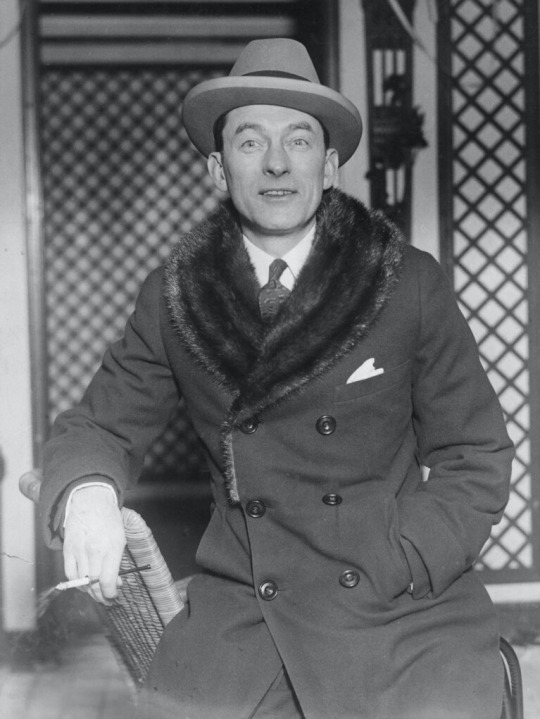
Compared to Wood, the faults of every other NYC mayor seem like the most minor of venal sins.
"Gentleman" Jimmy Walker was corrupt as fuck - supporting his lavish lifestyle by taking bribes from anyone with a pulse, selling the services of the NYPD to the mob, getting in bed with Arnold Rothstein, and perhaps having been connected to the murder of a whistleblower on police corruption and the disappearance of a New York Supreme Court judge - but he was also part of the progressive wing of Tammany Hall and a talented administrator (albeit one who only worked from 3-5 so as not to interfere with his more important time with showgirls, nightclubs, speakeasies, and boxing matches). He supported social welfare policies, opposed the KKK, built municipal waterworks and subway lines (albeit through corrupt contracts), and created the Sanitation and Hospitals Departments.
Similarly, William O'Dwyer was a typical Tammany politician who oversaw a massive police corruption scandal in Brooklyn, and ultimately had to flee to Mexico to avoid investigations from the Justice Department and the Brooklyn DA into his ties with organized crime, but he was in most other respects a typical if unremarkable mid-century NYC Mayor.
Shouldn't have raised the subway fare to ten cents, tho.
#history#u.s history#nyc history#nyc mayor#fernando wood#may he burn in hell#jimmy walker#william o'dwyer#tammany hall#political machines#urban politics
28 notes
·
View notes
Text
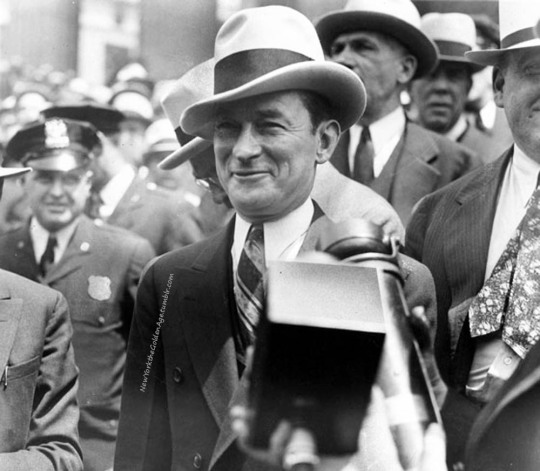
Mayor Jimmy Walker, looking as cheery and confident as ever, enters a courthouse on May 25, 1932. He was questioned by Samuel Seabury, chief counsel for the Hofstadter committee investigating political corruption in the city. Later, 15 charges were levelled against Walker and, under pressure from Governor Franklin D. Roosevelt, who was running for president, he resigned on September 1.
Photo: Associated Press via NY Magazine
27 notes
·
View notes
Text

Lincoln Crushing the Dragon of Rebellion
David Gilmour Blythe
oil on canvas, 1862
#David Gilmour Blythe#art#artist#painter#painting#Lincoln Crushing the Dragon of Rebellion#oil on canvas#1862#what a trip#Boss Tweed#Tammany Hall
26 notes
·
View notes
Photo
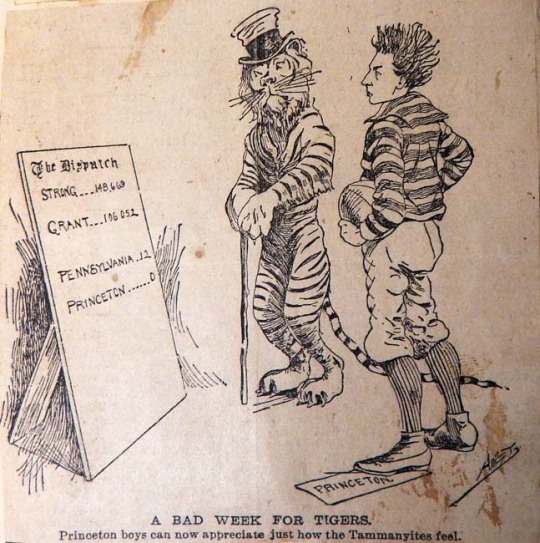
Tiger Tuesday: This is another of the editorial cartoons that Emory Leyton Ford, Class of 1896, posted in his scrapbook about a significant loss in football. In 1894, Princeton lost a match against the University of Pennsylvania, who scored 12 against Princeton’s 0. Here, the “bad week for tigers” shown in the cartoon includes not just Princeton, but also Tammany Hall, a political powerhouse in New York that pretty well ran the Democratic Party locally and was represented by a tiger much in the same way that donkeys represent Democrats and elephants represent Republicans today. The Tammany candidate for mayor, scandal-plagued Hugh Grant, lost to William Strong, who ultimately catapulted a new face in the Republican party when he nominated a new, anti-corruption police commissioner: Theodore Roosevelt. Thus, Princeton’s loss was only one major defeat for tigers in the fall of 1894.
Scrapbook Collection (AC026), Box 199
The entire Tiger Tuesday series
#1890s#tiger#TigerTuesday#Princeton#football#Tammany Hall#New York#election#mayor#Penn#Pennsylvania#athletics#Princetonsports#Theodore Roosevelt
4 notes
·
View notes
Text
Paula could run a small crime empire, Paula could run Tammany Hall, Paula has that Al Capone, Boss Tweed swag.
2 notes
·
View notes
Photo

The Spoiled Child
September 27, 1906
Willie' Hearst has the Independence League ragdoll, half the Tammany Tiger, and half of New York Democracy; Sulzer has the rest of the tiger and Jerome the rest of the donkey. On his head is the Daily Yellow newspaper.
The caption reads "Oh, yes, he's got 'em! What's left of them."
Hearst had already secured the Independence League nomination for governor, but now had also managed to gain the Democratic Party's support as well. The convention had been split, with Hearst taking a good portion of the vote, but William Sulzer taking part of the Tammany vote, and William Jerome part of the Democratic establishment vote.
See Also: William Randolph Hearst; Tammany Hall
From Hennepin County Library
Original available at: https://digitalcollections.hclib.org/digital/collection/Bart/id/6157/rec/255
#Charles Bartholomew#political cartoon#William Randolph Hearst#william travers jerome#william sulzer#tammany hall#new york history#governor#democratic party
1 note
·
View note
Text

I've been meaning to post about this beautiful building at 207 East 32nd Street in the Murray Hill neighborhood. Until recently it was under renovations after being purchased by the New York Times Review of Books (NYRB) in 2020. Prior to the NYRB, the building was owned by famed graphic designer and Bronx-born Milton Glaser (June 26, 1926 - June 26, 2020.)
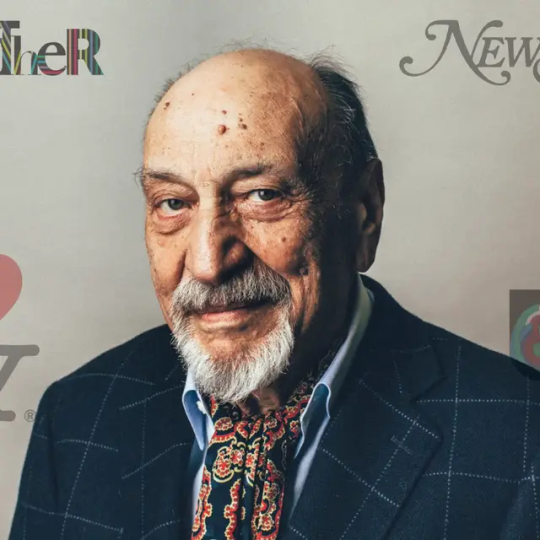
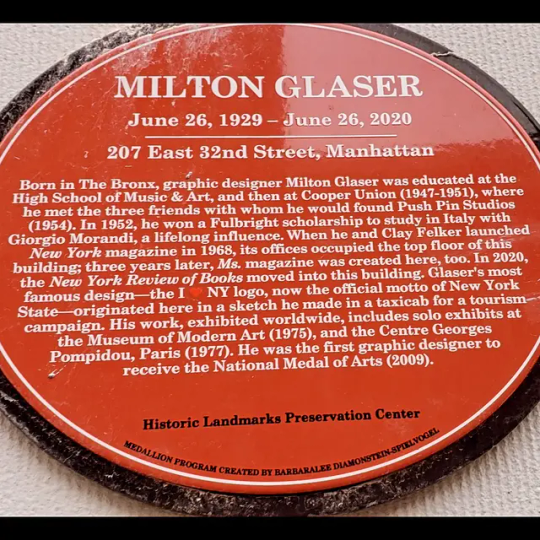
Glaser bought the 1902 Beaux-Arts building in 1965 which was initially built for the famed (or infamous) New York political machine Tammany Hall. According to legendary New York Times writer Christopher Grey in his post "Where the Ghosts Smoke Cigars" from Streetscapes dated December 19, 2013.
"The architect, Robert T. Lyons, developed an exuberantly French facade of red brick and limestone, with a mansard roof; although showy for 32nd Street east of the Third Avenue El, it was worthy of any lot on Fifth Avenue. Lyons presumably gave it a few smoke-filled rooms, and it also had a top-floor gymnasium, card rooms and an assembly hall for political conventions."
After Tammany Hall, the building was used by the City of New York as a courthouse.
Aside from being co-founder of New York Magazine in 1968 (with Clay Felker,) Glaser is arguably best known for his iconic "I ❤ NY" logo.
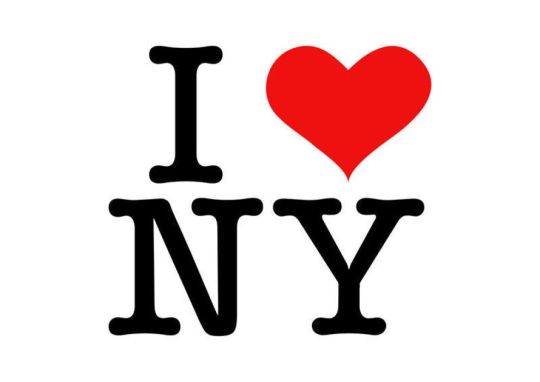
Glaser is believed to have created the logo during a cab ride and it started being used in 1977. Glaser created the logo with the best interests of New York City at heart during a dark period in the city's history when crime was rampant, nearing bankruptcy and the metropolis was being referred to as "Fear City." Glaser created the logo on a pro-bono basis.
The renovation of the building was completed in February of this year with Glaser's "Art is Work" remaining part of the new front door.

#Milton Glaser#I Love NY#I❤NY#Tammany Hall#Architectural History#New York History#NY History#History#Historia#Histoire#Geschichte#HistorySisco#New York City History#NYC History
1 note
·
View note
Text
Bowery Boys gang leader William “Bill the Butcher” Poole was shot in the chest by a gang from arch-rival John Morrissey’s Irish-American-led political group Tammany Hall. February 25, 1855.
Image: An 1888 engraving of boxer/gang leader William “Bill the Butcher” Pool. (Public Domain)
On this day in history, February 25, 1855, Bowery Boys gang leader William “Bill the Butcher” Poole was shot in…
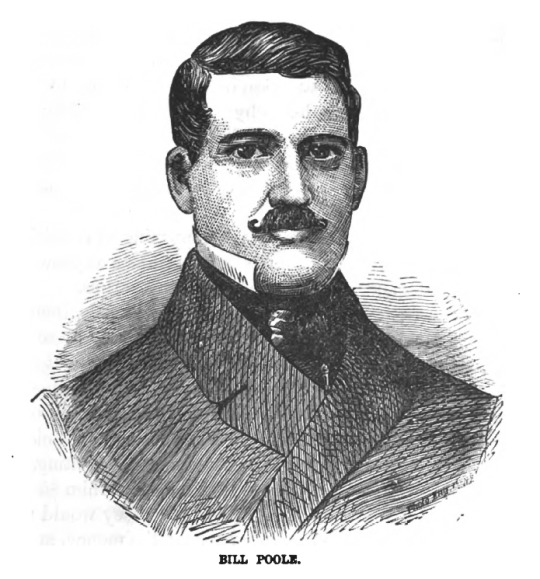
View On WordPress
0 notes
Text
Are The Dems Trying To Resurrect The Tammany Machine?
The Tammany Machine And The Evolution of Machine Politics

View On WordPress
#corruption#Deep State#Democracy#democrats#election interferance#great replacement theory#illegal aliens#immigration#tammany hall#tammany machine#undocumented#voter fraud
0 notes
Photo







Tammany Hall, also known as the Society of St. Tammany, the Sons of St. Tammany, or the Columbian Order, a New York City political organization was incorporated on May 12, 1789, as the Tammany Society.
#Tammany Hall Building#44 Union Square#Thompson Holmes & Converse#Charles B. Meyers#neo-Georgian#100 East 17th Street#Manhattan#travel#summer 2019#original photography#architecture#glass dome#vacation#construction workers#Tammany Hall#Society of St. Tammany#New York City#Sons of St. Tammany#political organization#corruption#12 May 1789#US history#anniversary#2013
0 notes
Text
John Pintard: Forgotten Founding Father
John Pintard: Forgotten Founding Father
It’s hard to think of anyone so important to American history yet more obscure than John Pintard (1759-1844). I only know about him because he founded New York’s oldest museum and library, the New-York Historical Society, where I worked for many years.
Pintard really has nothing to do with show business; I honor him here today as an outgrowth of the fact that my love for vaudeville, silent film,…

View On WordPress
0 notes
Note
Who do you consider to have been some of the most important / formative mayors of New York?
This is a great question, and actually rather difficult to answer, because for the longest time both Tammany Hall and the Whig/Republican machine tended to prefer mayors who were dull but reliable non-entities. Starting in 1824, NYC was divided into wards that elected Aldermen and Assistant Aldermen to the Board of Aldermen and the Board of Assistants, who together made up the bicameral Common Council. This led to a system whereby the real political action was shunted to the local level, where the ward's Aldermen and the ward boss (and his precinct bosses) ran the show.

The downfall of Boss Tweed led to some reforms, with the bicameral Common Council replaced by a unicameral Board of Aldermen who were elected from larger State Senate districts or at-large, as part of the Whig Party's drive to dilute the power of Tammany's Irish Catholic voting base. This would change somewhat when the five boroughs were consolidated into Greater New York in 1898, which added the borough presidents and the Board of Estimate into the mix, and then again in 1901 and so forth.
However, the overall trend was a weak mayor system where real political power was fairly evenly distributed between aldermen (who were not only the city's legislatures but were also represented on the Board of Estimate through their President), the borough presidents, the mayor, and the comptroller.
So the major players in NYC politics tended not to be mayors:

Dewitt Clinton was incredibly transformational, but despite serving three terms as mayor his real mark on New York was as governor where he was the driving force behind the construction of the Erie Canal.
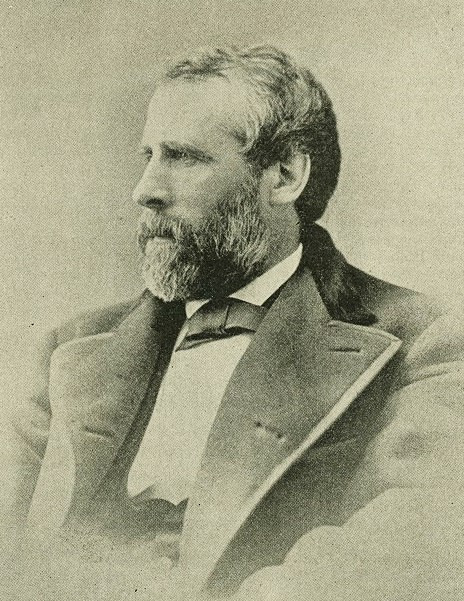
Andrew Haswell Green, the "Father of Greater New York," was responsible for the creation of Central Park, the New York Public Library, the Bronx Zoo, The Museum of Natural History, the Metropolitan Museum of Art, Riverside, Morningside, and Fort Washington Parks, Columbus Circle, and the consolidation of Greater New York - but he never served as mayor. The original Robert Moses, Green's political power came from his leadership of the Central Park Commission, the Greater New York Commission, a six-year stint in the Comptroller's office, and his position on a number of NGOs.
But if we're talking transformative mayors, there is one name that rises above all the rest: Fiorello goddamn LaGuardia.

There had been other reform mayors before him - Seth Low had established the Civil Service, John P. Mitchel brought scientific management to city government - but none of them had ever been able to get re-elected. Unlike the wealthy WASP reformers, LaGuardia knew how to beat Tammany at the ethnic politics game. Tammany's strength had always been in the Irish wards of the city, and while they had tried to divide-and-rule by promoting the naturalization of Russian and Polish Jews in return for them voting for Irish-American politicians in the Lower East Side while noticably neglecting the naturalization of Italians, the emergence of second-generation Jewish and Italian voters meant that this strategy had run its course.
Born to a Sephardic mother from Trieste and a lapsed Catholic father from southern Italy, Fiorello had an astonishing knack for transcending ethnic political boundaries in New York City - he spoke Italian, German, Yiddish, and Croatian, but he was also a progressive Republican and Episcopalian (which meant he could speak middle-class WASP too). LaGuardia won the 1933 mayoral election by bringing together a Fusion coalition that brought middle class German-American Republicans together with Italians and Jews, a coalition that he would expand in 1936 by bringing socialists, unions, and black voters together into the American Labor Party.
Over his twelve years as Mayor, LaGuardia was almost pathologically active (in a way that's oddly reminiscent of Henry II), transforming almost every aspect of New York City:
Jobs for the Unemployed:
LaGuardia's immediate mission as mayor was to fight the Great Depression that had had left a third of the City unemployed. He did this by forming an enduring alliance with FDR in which the New Deal would provide NYC with unpredecented level of federal support in exchange for NYC becoming the New Deal's model city - the first of the "Little New Deals." In his first hundred days in office, LaGuardia convinced FDR to give New York City a full 20% of the Civil Works Administration's work relief budget. This put 200,000 New Yorkers back to work - and this would only be the beginning of New York City's experiments with direct job creation.
As part of Fiorello LaGuardia's "Little New Deal," LaGuardia's new Parks Department employed 70,000 workers - paid for by CWA and later WPA money - to rebuild New York City's parks, constructing the Central Park Zoo and 60 playgrounds in the first year.
When the New Deal created the Works Progress Administration in 1935, LaGuardia once again lobbied FDR to put NYC first in line. This culminated in some 700,000 New Yorkers - a tenth of the city's entire population - getting jobs through the WPA and other New Deal programs. Together with the Parks Department, LaGuardia and Robert Moses would mobilize this workforce to completely transform the city.
Public Works:
This is where we have to discuss Fiorello LaGuardia's fateful decision to make Robert Moses his master builder. While Moses was in the process of becoming the "Power Broker" before LaGuardia - he had already been made president of the Long Island State Park Commission and chairman of the New York State Council of Parks - LaGuardia enabled his ascent to the heights of power by making him Parks Commissioner, Commissioner and then Chairman of the Triborough Bridge Authority, Commissioner of the NYC Planning Commission, and Chairman of the Emergency Public Works Commission.
The pact between them was simple: LaGuardia would give Moses the public appointments he needed to consolidate public works across the city and would steer New Deal public works money through Moses' agencies, and in exchange Moses would be LaGuardia's master builder with a mandate to "build it quickly and build it well." This was not an easy task, because Robert Moses was a political enemy of FDR and FDR tried to bar him from being given any WPA or PWA funding, but the mayor was able to persuade Roosevelt that it was more important that LaGuardia's proposed $1 billion public works program for NYC be carried at speed and administered efficiently.
As LaGuardia's workhorse, Moses would oversee almost all of NYC's public works, including the West Side Highway, the future FDR Drive, the Brooklyn Battery Tunnel, the Triborough Bridge, the LaGuardia and future JFK Airports, and Jones Beach Park, among others. LaGuardia would also construct the Sixth Avenue Subway line, the Queens-Midtown Tunnel and the Lincoln Tunnel without Moses (who was completely uninterested in mass transit and who always preferred bridges to tunnels).
In addition to these major projects, LaGuardia with and without Moses built the city's first municipal power plants, 37 sewage treatment plants, 9 fire houses, 142 elementary schools and 22 high schools, half of NYC's then-23 municipal hospitals, eight District Health Centers to provide preventative, specialized, and public health immunization care, and the first 14 of the City's public housing projects.
City Government:
To dismantle Tammany's patronage system, he began to massively expand the civil service to eliminate patronage jobs, and then when Tammany beat him on a government reform bill in 1934, he simply kept pushing. He pushed through the LaGuardia Reform Charter of 1938 that abolished the Tammany-dominated Board of Aldermen and replaced it with a City Council elected by Single Transferrable Vote, established the Board of Estimate as a central administrative body with powers over the city budget, public contracts, franchises, and land use - crippling Tammany's ability to raise money through graft and kickbacks.
To transform New York City into a "strong mayor" model, he undertook a campaign of transforming independent agencies scattered across the five boroughs into a system of unified citywide departments or public authorities that answered directly to the mayor and gave him unprecedented state capacity. In 1934, he formed the Parks Department and the New York City Housing Authority; in 1936 he formed the Department of Buildings and the City Planning Commission; in 1938, he restructured the Department of Welfare to run the city's social welfare programs and a massively expanded public hospital system; in 1940, he took over the IRT (operating the 1, 2, 3, 4, 5, 6), and the BMT and IND (operating the A, B, C, D, E, F, G, J, L, M, N, Q, R, W, and Z lines), unifying the NYC subway system for the first time.
To deal with police corruption, LaGuardia appointed Lewis Valentine to purge the NYPD so that the mayor could use it (and Thomas Dewey) in a crusade against the mafia's gambling, racketeering, and vice operations. This marked a rare period of honesty and effectiveness in the NYPD, although after WWII the system of protection rackets and mafia corruption would eventually re-establish itself.
Ironically, this exhaustive list of accomplishments really made it hard for later mayors to distinguish themselves, because mostly their task was completing, managing, or mis-managing the system that LaGuardia had built. After LaGuardia I would say that Robert Wagner Jr. (established public sector collective bargaining, created CUNY, Lincoln Center, Shakespeare in the Park, and dealt the killing blow to Tammany) and John Lindsay (see my previous post, but chiefly scatter-site housing, the civilian complaint review board, and the Knapp Commission on police corruption) are on my list of formative mayors.
After them, there have been long-serving mayors and good mayors, but unfortunately not the two combined.
#history#historical analysis#nyc history#nyc mayor#fiorello laguardia#tammany hall#urban history#urban studies#urban politics#political machines#new deal#robert moses#infrastructure
28 notes
·
View notes
Photo
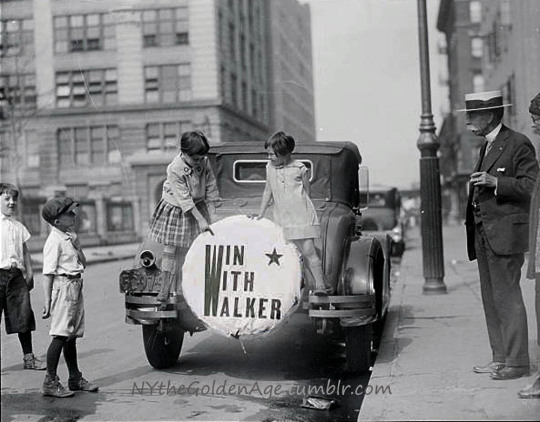
Catherine and Lorraine Bell, neighbors of State Senator James J. Walker, are backing the Tammany candidate for the mayoralty nomination, Friday, August 7, 1925. He ran against incumbent John Francis Hylan, and won.
Photo: Bettmann Archives/Getty Images
#New York#NYC#vintage New York#1920s#Tammany Hall#Jimmy Walker#James J. Walker#campaign#campaigning#primary election#August 7#Aug. 7#political corruption
55 notes
·
View notes
Text
…later worked as a personal assistant to Reed Erickson, a fabulously wealthy female-to-male transsexual who had made his fortune extracting lead from old car batteries and selling it to the petroleum industry as a gasoline additive.
—Queer Pulp
Diversity win! The man who put the lead in leaded gasoline was transgender!
#feel like everytime I read about a trans man from before the 70’s he’s like. a bad person in some way.#If Krafft-Ebing is to be believed Tammany Hall was flush with them.
236 notes
·
View notes
Text
oomves sending me posts knowing that im a guaranteed reblog.... the network of tumblr corruption runs deep
6 notes
·
View notes
Text
couple seeking a third (for >2 player board games)
#there's one based on tammany hall but it's 3 ppl and my main board game friend lives an hour away. pain and suffering on planet earth#rodya.txt
3 notes
·
View notes